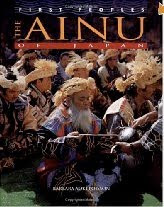
When R.I.C. Publications published our translation of Shigeru Kayano's The Ainu and the Fox in 2006, they included a CD with every book. This is something they regularly do with their line of children's storybooks. The CD that came with The Ainu and the Fox contained a recording of the text plus selections of tonkori performances by Ainu musician Oki. In the process of exploring his Ainu roots, Oki revived the nearly extinct tonkori and developed his own interpretations of traditional Ainu tunes. He often fuses traditional Ainu music with that of other genres such as reggae and dub. For the CD that is due to accompany the Iyomante book we are thinking of going with Ainu music that is more starkly traditional. We have an idea of who we are going to ask, but it's not official yet. I'll blog the details when everything is settled.
In the meantime, I wanted to tell you about MOSHIRI, an Eastern-Hokkaido based group that does a thrilling stage performance of Ainu dance and song. I was privileged to see this group perform in Sapporo many years ago, and was entranced by the drama of their performance. The men's dances, which are not often performed elsewhere, are especially intriguing. For the musical background to the dances, traditional instruments are supplemented by modern, non-traditional ones, so the music is fuller than it would be in basic, traditional Ainu tunes. MOSHIRI CDs can be ordered from their website (Japanese only) or purchased at their concerts (which are few and far between). Otherwise you have to travel to Lake Kussharo in eastern Hokkaido where the leader of MOSHIRI and his clan operate the Marukibune inn with regular stage performances for tourists.












